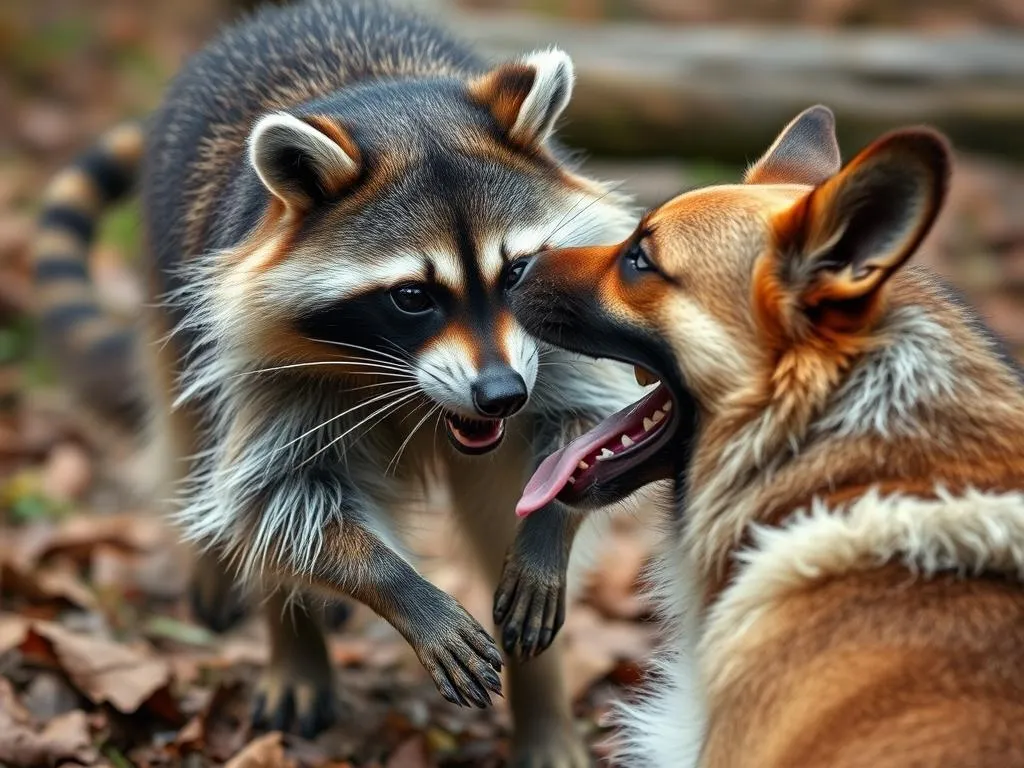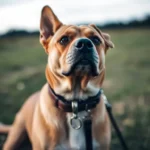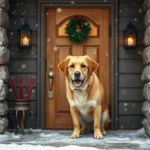
When it comes to wildlife encounters, many pet owners find themselves wondering about the safety of their beloved dogs, especially regarding interactions with raccoons. These clever creatures are often spotted rummaging through trash cans or exploring backyards, leading to questions about their behavior and potential aggression towards domestic animals. Understanding raccoon behavior can help pet owners navigate these encounters and ensure their pets remain safe.
Understanding Raccoons
General Characteristics of Raccoons
Raccoons are medium-sized mammals known for their distinctive black “mask” of fur around their eyes and their bushy tails adorned with rings. Adult raccoons typically weigh between 10 to 30 pounds and can measure about 2 to 3 feet in length, not including their tails. They are highly adaptable animals, thriving in both urban and rural environments. Their ability to climb and swim, along with their keen problem-solving skills, allows them to access food sources that many other animals cannot.
In urban areas, raccoons are often seen foraging through garbage or investigating backyards. In rural areas, they may be spotted near farms or wooded regions. Understanding their physical traits and habitat preferences can provide insight into their behaviors and interactions with domestic animals.
Raccoon Behavior
Raccoons are primarily nocturnal, meaning they are most active at night. This behavior allows them to avoid many predators and human encounters. They are social animals that often live in family groups, usually consisting of a mother and her young. Raccoons are opportunistic feeders, which means their diet can include a wide variety of foods, from fruits and nuts to human leftovers. Their scavenging tendencies can lead them to areas where pets are present, heightening the potential for encounters with dogs.
Raccoons and Domestic Dogs
Do Raccoons Attack Dogs?
One of the most pressing concerns for dog owners is whether raccoons will attack their dogs. While raccoon attacks on dogs are not extremely common, they can occur, particularly under certain circumstances. Raccoons are generally more inclined to avoid confrontation, but if they feel threatened or cornered, they may exhibit aggressive behavior.
Factors such as territoriality and the search for food can influence a raccoon’s aggression. For instance, if a dog approaches a raccoon that is protecting its young or feeding, it may provoke an attack. Additionally, raccoons are known to defend themselves if they feel threatened, which can lead to aggressive encounters with dogs.
Size and Breed Considerations
The size and breed of a dog can significantly affect the likelihood of a raccoon encounter. Smaller dogs may be perceived as more vulnerable, and therefore, may attract more attention from raccoons. Breeds like Chihuahuas or Dachshunds could be more at risk during encounters. Conversely, larger breeds such as German Shepherds or Labrador Retrievers may be less likely to provoke a raccoon, but they can still engage in confrontations if they exhibit aggressive behavior towards the raccoon.
Understanding your dog’s temperament is crucial. Dogs that are naturally curious or aggressive may be more prone to approaching raccoons, increasing the chances of an encounter.
Signs of Raccoon Encounters
Behavioral Signs in Dogs
Dogs often communicate their feelings through behavior. If a raccoon is nearby, your dog may exhibit signs such as barking, growling, or whining. These vocalizations often signal excitement, fear, or aggression. It’s important for dog owners to recognize these signs to assess the situation accurately.
Additionally, dogs may display signs of distress, such as pacing or attempting to hide. If your dog is noticeably agitated or fixated on a particular area, it may indicate the presence of a raccoon or another animal.
Physical Signs of an Encounter
After an outdoor adventure, monitoring your dog for any physical signs of an encounter with a raccoon is vital. Look for scratches, bites, or unusual behavior that may indicate a confrontation. Raccoons have sharp teeth and claws, and any injuries should be taken seriously.
If you notice any open wounds or significant changes in your dog’s behavior, it’s essential to consult a veterinarian. Early intervention can prevent complications and ensure your dog’s health and safety.
Risk Factors for Raccoon Attacks
Environmental Factors
Certain environments are more conducive to raccoon encounters. Areas such as parks, wooded trails, or even suburban neighborhoods with abundant food sources can attract raccoons. Pet owners should remain vigilant in these settings, especially at night when raccoons are most active.
Seasonal variations can also impact raccoon behavior. During mating season in the spring, raccoons may exhibit increased territoriality. Additionally, food scarcity in the winter months can lead raccoons to venture closer to human habitats in search of food, making encounters with dogs more likely.
Dog Behavior and Training
A dog’s behavior can either attract or deter raccoons. Dogs that are well-trained and socialized are less likely to engage in aggressive behavior that provokes a raccoon. Training your dog to have a reliable recall can be invaluable in preventing encounters.
Conversely, dogs that exhibit aggressive tendencies or are overly curious may be more prone to confrontations. Understanding your dog’s behavior and providing appropriate training can help mitigate risks associated with raccoon encounters.
Preventive Measures
Keeping Dogs Safe
To keep your dog safe from raccoons, several strategies can be implemented. Fencing your yard can create a physical barrier that prevents raccoons from entering. Additionally, supervising your dog during outdoor play can help you monitor their behavior and intervene if necessary.
Leash training is essential, especially in areas where raccoons are known to roam. Keeping your dog on a leash allows you to maintain control and can prevent them from approaching a raccoon.
Home and Yard Security
Securing your home and yard can reduce the attraction of raccoons. Proper waste management practices, such as using raccoon-proof trash cans and ensuring that food scraps are disposed of correctly, can deter raccoons from visiting your property. Additionally, removing any potential food sources, like pet food left outside, can help minimize encounters.
Creating a tidy yard by clearing away debris and ensuring that compost bins are securely closed can also reduce the likelihood of attracting raccoons.
What to Do if a Raccoon Attacks
Immediate Actions
If a raccoon attacks your dog, staying calm and assessing the situation is crucial. Do not attempt to intervene physically, as this can put you at risk of injury. Instead, try to distract the raccoon using loud noises or throwing objects (not directly at the raccoon) to create a diversion.
Once the raccoon has left the area, check your dog for injuries, and if necessary, seek veterinary assistance as soon as possible.
Veterinary Care
After an encounter, it’s important to monitor your dog for any signs that may require a vet visit. Symptoms to watch for include excessive bleeding, swelling, or signs of infection. Raccoons can carry diseases such as rabies, which poses a serious health risk to both pets and humans.
If your dog has been bitten or scratched, even if the wound appears minor, consulting a veterinarian is essential. They can assess the injury, provide necessary treatment, and discuss vaccination updates or preventive measures.
Conclusion
Understanding the dynamics between raccoons and dogs is essential for any pet owner. While raccoon attacks on dogs aren’t exceedingly common, they can happen, particularly in specific environments and under certain circumstances. Awareness of raccoon behavior, environmental factors, and your dog’s behavior can help mitigate risks.
By taking preventive measures, such as securing your home and training your dog, you can create a safer environment for both your pet and the wildlife that inhabits your area. Remember, it’s always better to be proactive than reactive when it comes to your dog’s safety.
As a responsible dog owner, sharing your experiences or seeking professional advice can aid in fostering a community that prioritizes the well-being of pets and wildlife alike.








